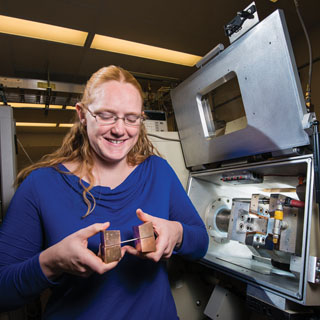
Sandia researchers Lisa Deibler and Arthur Brown had a ready-made problem for their computer modeling work when they partnered with NNSA’s Kansas City Plant to improve stainless steel tubing that was too hard to meet nuclear weapon requirements.
When steel is too hard it becomes brittle, so the plant ended up getting new tubing. However, Lisa says KCP needed a backup in case it couldn’t find replacements in time to meet deadlines.
Sandia’s modeling, coupled with experiments, allowed the rapid design of an annealing process to soften the tubing while keeping the metal’s desired structure. The model predicted how the microstructure would be affected by variations in the process, which improved researchers’ confidence that the heat treatment would produce parts that met specifications.
Arthur (8259), a modeler at Sandia/California, says working on the model was a natural extension of a larger project, supported by
Sandia’s Nuclear Weapons program, called Predicting Performance Margins. Under that program, numerous Sandia researchers are studying the way microstructure affects properties of materials at various scales. Arthur became involved in the project as a member of a team that developed a thermal-mechanical modeling tool to predict how microstructure and properties change during forging. That led to his collaboration with Lisa and her technical adviser, Joe Puskar (1831), on thermal profiles for welds.
When the need arose to address the tubing issue, Arthur says Joe contacted him to see if Arthur could work with Lisa to help optimize a heat treatment.
Experiments, modeling work together
Lisa, a post-doc in Sandia/New Mexico’s Materials Characterization and Performance Department, provided experimental data that Arthur fed into his model of recrystallization in stainless steel. Recrystallization, in which grains in deformed microstructures are replaced by strain-free grains, occurs during annealing — the process of heating metal to dissipate energy built up while the metal is compressed, twisted, or otherwise worked. Heat makes the metal softer and more ductile.
Lisa and Arthur were able to solve the plant’s real-life problem since recrystallization is part of the annealing process. And they were able to do it quickly because the model already existed.
Lisa’s experiments indicated it was important to model two softening mechanisms, recovery and recrystallization. Recovery occurs first within a microstructure when material is heated to soften it. By measuring the hardness and the amount of recrystallization after each heat treatment, Arthur and Lisa identified how much softening was due to recovery.
“It was important to model both softening mechanisms because we were seeing microstructures that contained no new recrystallized grains, but which had changed properties from the initial deformed material,” Lisa says. “By failing to include the effects of recovery, our model couldn’t predict why the properties weren’t the same as the initial deformed material. Adding in recovery allowed us to account for the changed properties in microstructures with no recrystallization.”
She described the work in a poster, “Design of a Heat Treatment to Soften Stainless Steel Tubing,” presented at Sandia’s winter 2012 Post-Doctoral Technical Showcase.
Solution required baseline for model
The team first developed a baseline for the model. Lisa performed heat experiments on the steel tubing since she didn’t know the conditions under which it was manufactured. That effort required “a lot of shipping tubing around the country for various heat treatments,” she recalled.
She put tubing samples in Sandia’s thermal-mechanical experimental system at various temperatures for different lengths of time. Then she had the tubing sectioned, polished, and etched, and analyzed the images to see how much the microstructures had recrystallized. Arthur fit her data with the model to simulate different heat treatments.
The simulation also required knowing something about the furnace where the tubing would be softened. Heating a furnace quickly tends to overshoot the desired temperature, so the team used the model to determine whether it was better to heat the furnace quickly or slowly raise it to the correct temperature, Lisa says. Once Arthur identified the optimal rate of increase and other factors, KCP technicians filled a furnace with tubing and measured the temperature at several locations inside. Arthur then ran those profiles through the model, which allowed him to predict the impact of temperature variations on the tubing’s final properties.
Looking ahead
The researchers want the model to handle both forging and welding because in some ways the two pro-cesses work against one another. Forging steel gives it a strong microstructure, but welding adds heat that can destroy those properties. “So if you were able to model that process, that would provide a lot more confidence in the overall modeling that their parts aren’t going to fail,” Lisa says.
In the future, the researchers want to use the model for all kinds of welding at Sandia: laser welding, resistance welding, and gas tungsten arc welding. Types of welding vary in their thermal rates — how fast something is heated.
“Looking at how different heating and cooling rates affect the microstructure during welding would give us valuable information,” Lisa says.